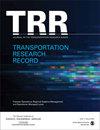利用行人-左转弯重叠改善多级交叉路口的行人通行
IF 1.8
4区 工程技术
Q3 ENGINEERING, CIVIL
引用次数: 0
摘要
在有信号的十字路口,行人过路被中间岛划分为两个阶段,如果部分过路阶段进展不佳,行人的延误可能会很长。减少行人延误的一种技术是行人-左转重叠,其中允许在左转阶段和平行车辆通过阶段运行与左转不冲突的半交叉。这样的重叠可以使一些行人一次通过,或者在中间等待的时间短得多。由于这种技术需要放弃一些通常左转阶段操作的灵活性——在有行人呼叫的阶段,不能跳过左转阶段,并且可能需要更长的最小绿灯时间——这也可能对车辆延误产生影响。对马萨诸塞州Brookline两个十字路口的案例研究发现,与目前的计时计划相比,使用行人左转重叠可以将行人的延误从大约100秒减少到35秒,而对车辆延误的影响可以忽略不计。本研究中引入的一项方法创新是,计算了三种行人速度的平均行人延迟,并将其平均在一起,从而解释了为什么在多级人行横道上,速度较快的行人可以一次通过,而速度较慢的行人必须在人行横道岛等待,行人延迟要低得多。本文章由计算机程序翻译,如有差异,请以英文原文为准。
Improving Pedestrian Progression at Multistage Crossings Using Pedestrian–Left Turn Overlaps
At signalized intersections where pedestrian crossings are divided into two stages by using a median island, pedestrian delay can be very long if the partial-crossing phases have poor progression. One technique for reducing pedestrian delay is pedestrian–left turn overlaps, in which half-crossings that are not in conflict with a left turn are allowed to run during the left turn phase as well as during the parallel vehicle through phase. Such an overlap can enable some pedestrians to cross in a single pass, or to have a far shorter wait at the median. Because this technique requires surrendering some of the flexibility with which left turn phases normally operate—in phases with a pedestrian call, the left turn phase cannot be skipped and may require a longer minimum green—there can also be an impact on vehicle delay. A case study of two intersections in Brookline, MA found that, compared with the current timing plan, using pedestrian–left turn overlaps could reduce pedestrian delay from about 100 to 35 s, with a negligible impact on vehicle delay. A methodological innovation introduced in this study was that average pedestrian delay was calculated for three pedestrian speeds and averaged together, thus accounting for how pedestrian delay at multistage crossings can be far lower for faster pedestrians who may be able to cross in a single pass than for slower pedestrians who have to wait at the crossing island.
求助全文
通过发布文献求助,成功后即可免费获取论文全文。
去求助
来源期刊

Transportation Research Record
工程技术-工程:土木
CiteScore
3.20
自引率
11.80%
发文量
918
审稿时长
4.2 months
期刊介绍:
Transportation Research Record: Journal of the Transportation Research Board is one of the most cited and prolific transportation journals in the world, offering unparalleled depth and breadth in the coverage of transportation-related topics. The TRR publishes approximately 70 issues annually of outstanding, peer-reviewed papers presenting research findings in policy, planning, administration, economics and financing, operations, construction, design, maintenance, safety, and more, for all modes of transportation. This site provides electronic access to a full compilation of papers since the 1996 series.
 求助内容:
求助内容: 应助结果提醒方式:
应助结果提醒方式:


